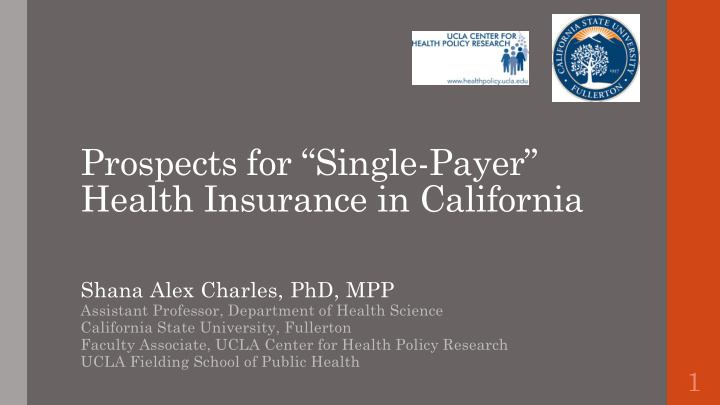



Prospects for “Single-Payer” Health Insurance in California Shana Alex Charles, PhD, MPP Assistant Professor, Department of Health Science California State University, Fullerton Faculty Associate, UCLA Center for Health Policy Research UCLA Fielding School of Public Health 1
Recent Turning Points in California’s Journey to Universal Coverage • SB 2 “Pay-or-play” financing scheme building on current job-based system. Fee on employers who do not offer coverage to employees, to give access to health care. Signed by Gov. Davis, repealed by slim majority of voters. • SB 840 Income tax-based financing scheme that would have eliminated insurance companies in the state. Created a new state agency to manage either a FFS or salaried contract with each provider (or provider group) individually. Vetoed by Gov. Schwarzenegger 2
California Leads the Way for the ACA Nationwide • AB 1x Speaker Nu ñ ez and Governor Schwarzenegger attempted to replicate the MA Connector framework (precursor to the ACA). Rejected by State Senate for not being “single-payer,” under cover of questioning estimates of the uninsured. • ACA Implementation California was first state to adopt new legislation to implement the Exchange. 3 Largest gains in coverage nationwide are in California.
The ACA Has Worked, Faster than Projected
5
6
The ACA helps self-employed adults get health insurance. 7
The Political Divide 8
Where you stand depends on where you sit. 9
Democrats have an internal party struggle - Universal Coverage or Single-Payer? • Moderate Democrats want to build a “universal coverage” system: Keep ACA to build on as a foundation for future changes. Would retain insurance companies as partners with public system. Address consumer costs by expanding subsidies higher up the income scale. Expand ACO’s and medical home options for delivery system reform. • Designed to increase coverage and quality, but may also increase costs. • Seen by progressive opponents as a “sell-out” to health insurance companies. 10
Other “Single-Payer” plans proposed by Progressive wings. • SB 562 Revives government agency run health care envisioned in SB 840, with state negotiation with private providers. Health insurance companies may sell add-on plans for options not covered by the state. Financing and job loss are major points of contention. • Medicare For All (Federal level) Would expand Medicare down the age ladder to more groups, possibly to all citizens and legal permanent residents. Keep Medicaid as a supplement available for those who cannot afford to buy one on their own. Default coverage for entire population. 11
Alternate “Single-Payer” Plans • Tightly regulated managed competition Health Spending as a % of GDP, among health insurance plans financed 2016 through taxes (ex: Germany, 18.0 Netherlands). 16.0 Build on ACA marketplaces, funded in a 14.0 single stream through diverting premiums, deductibles, and nearly all cost-sharing to 12.0 a tax-based payment. 10.0 Keeps private delivery system in place, 8.0 with negotiations between plans and providers. 6.0 4.0 • Socialized system of providers paid directly on salary through taxes (Great 2.0 Britain). 0.0 Highly unlikely to be acceptable to providers in the U.S. 12 Source: 2016 OECD data, stats.oecd.org
“Healthcare isn’t a red issue or a blue issue -- it’s an American issue. People need healthcare.” -Peter Lee, CEO of Covered California, November 2016 13
Thank you! Dr. Shana Alex Charles, PhD, MPP Assistant Professor, Department of Health Science California State University, Fullerton Phone: 657-278-8436 Email: scharles@fullerton.edu 14
Recommend
More recommend